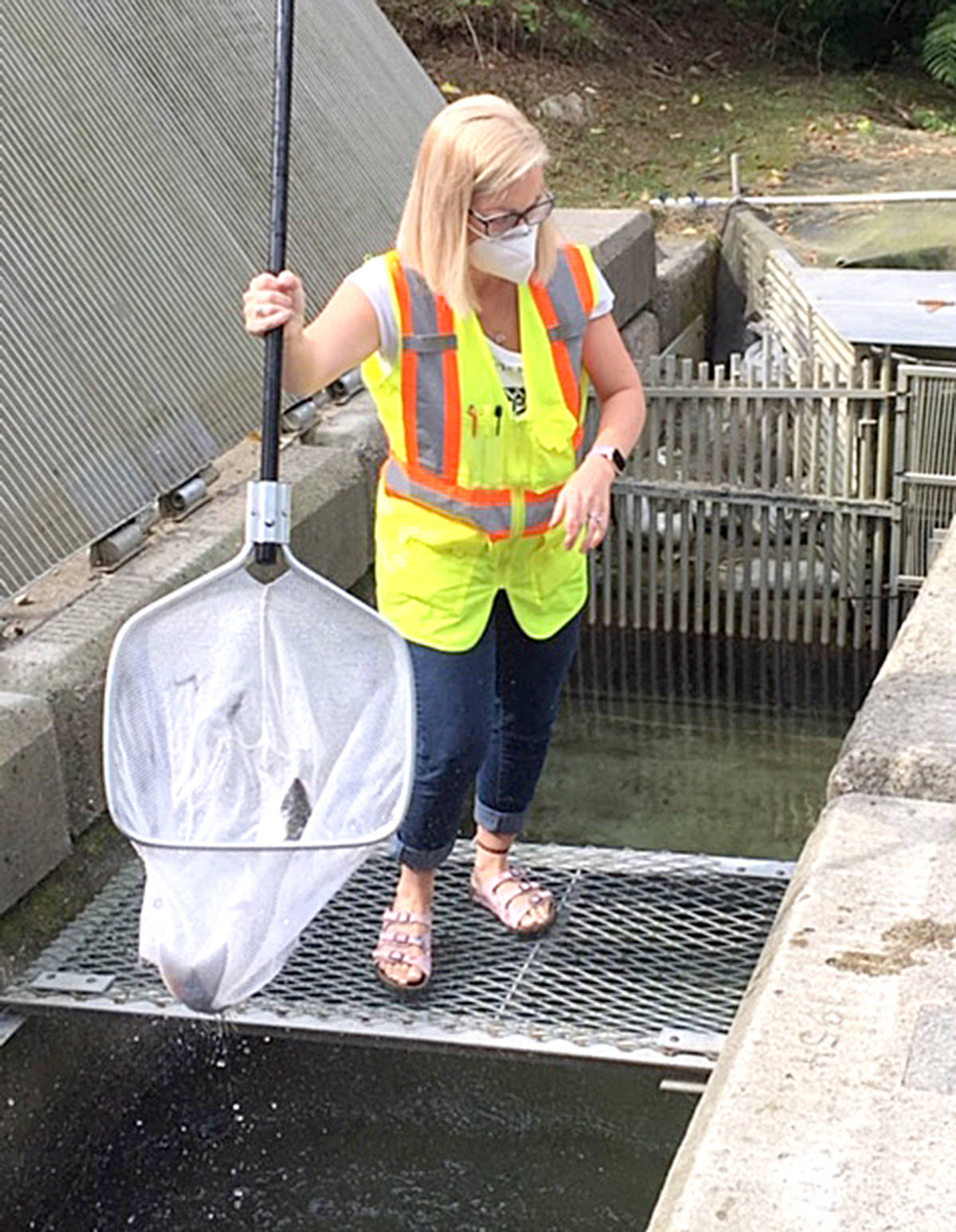by Jack Emberly/Special to The News
News for wild salmon goes from bad to horrific.
Twelve of 13 Fraser River chinook runs are recommended for protection under the Species at Risk Act.
Runs of 90 million salmon (mostly sockeye) were common once, but less than one million fish made it past the Big Bar landslide in 2019.
The Pacific Salmon Commission predicts 283,000 – the lowest number in history – for 2020.
But 80 sockeye have returned to the Allco fish fence in Maple Ridge, and Greta Borick-Cunningham, of Alouette River Management Society (ARMS), is “very excited.”
The average return is 20. In 2017, one showed up. In 2014 and 2015, none.
Not surprising. The Alouette dam (1928) blocked sockeye migration into the lake seven kilometres beyond the fish fence.
Today, the run’s survival hangs by a thread.
Since 2007 – ARMS and B.C. Corrrections staff and inmates, have been capturing, counting, and moving sockeye over the dam as part of the Alouette adult sockeye enumeration monitoring program, funded by BC Hydro – at the urging of ARMS, when landlocked kokanee accidentally released over the dam’s spillway in 2005, and returned as sockeye two years later.
It proved smolts could survive the drop.
ARMS now had a better argument for fish ladder funding.
Geoff Clayton is a tireless champion of Alouette sockeye. I asked him what would happen to returning sockeye if they weren’t trucked up.
“They would die in the river,” he says. “Spawning would be useless. Fry need a lake to rear in.”
Salmon will kill themselves trying to get past obstacles. Big Bar proved it again.
Clayton says he and hydro staff witnessed similar self-destruction at the base of the dam in 2007.
“They were jumping out of the river smashing their brains on the rocks,” he recalls, grimly.
This could have remained one of those dirty little secrets. That spot is remote and gated.
I’m seeing it today (Aug. 14), with Greta, as she transports two sockeye up the lake, but few others ever would.
“How was that situation dealt with by authorities in 2007?” I ask.
“BC Hydro put a chain fence up by the dam so they would bounce back into the river.”
That lame gesture outraged Clayton.
“I threatened them with TV coverage if they didn’t support getting them over the dam. They agreed to today’s truck-and-trailer system.”
August 14, 2020: “These are the cleanest fish I’ve seen in year,” says Greta.
ARMS staffer Sophie Sparrow called them “healthy and feisty.”
It takes a few minutes to collect tissue from adipose fins and scales destined for a Department of Fisheries and Oceans Ministry of Environment lab in Nanaimo. DNA tests are required by DFO to prove re-introduction to the lake is “feasible.”
B.C.Hydro wants proof potential returns would be sufficient to warrant a ladder; that the run could be sustained without depending on a hatchery, and that the fish are really sockeye and not kokanee – questions we already have answers to.
RELATED - ALONG THE FRASER: Fish ladder for Alouette dam would boost threatened wild sockeye
“We’ve only ever had two strays,” says Greta. “Except for them, they’ve been Alouette sockeye.”
Biologist and salmon expert Dr. Marvin Rosenau doesn’t find that surprising.
“They’re sockeye,” he says. “Of the two forms, only sockeye have the innate ability to adapt to a marine environment, go to sea, and come back. They haven’t lost that evolutionary capacity. Kokanee, genetically different stock, don’t have it,” the doc explained.
“Is the return of 80 salmon significant?” I ask.
“Yes,” he adds. “If 80 come back, we could have 10 times that return in four years. The lake could support 50,000, but today only about 1/10th of smolts migrate to sea over the dam (safe route). There are multiple lines of evidence 90 per cent are sucked through a water diversion tunnel to Stave Lake for hydro-electric use.”
“I believe most of the smolts that leave Alouette reservoir are entrained into Stave reservoir and lost to production. The tunnel flow is 10 times stronger than water flow over the dam, and sockeye smolts will follow the strongest current,” Rosenau said.
“Is a hatchery the answer?” I query. BC Hydro has offered ARMS $100,000 to operate a “egg-to-smolt” hatchery.
“No. The hatchery can’t be successful without first addressing the key mortality parameter, entrainment (sucked into a closed system and destroyed),” says the biologist.
“Much of the production into Alouette reservoir would be lost. It would be a wasted effort.”
So, what should be done for the next generation of smolts determined to reach the sea?
“Shut the tunnel down from mid-April to end of May, the six weeks during peak smolt migration,” Rosenau said.
Here’s Clayton: “We aren’t asking for this dam’s removal, just a low fishway that has already been costed out ($4 million) for ARMS by qualified engineers.”
By comparison, the Big Bar operation has cost $60 million, so far.
RELATED - ALONG THE FRASER: Fish and planet have no time to lose
It’s 11:30 a.m. At our release location, Greta – in hip waders – is encouraging the first sockeye from the net and flashes a thumbs up when it splashes excitedly in water it innately recognized.
Remember that old movie, Born Free?
I had a warm feeling knowing 80 or more would spawn where their ancestors did.
It’s time for decision-makers to commit to rebuilding wild fish stocks like Alouette sockeye without delay.
Clayton’s right: “All sockeye life matters.”
– Jack Emberly is a retired teacher, local author, and environmentalist
.
____________________
• If there is more to this issue, please let us know about it. Email us at editor@mapleridgenews.com. We look forward to hearing from you. In the meantime, like us on Facebook or follow us on Twitter.
